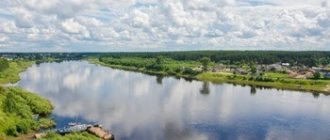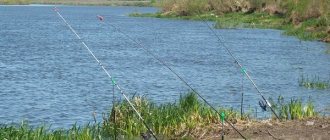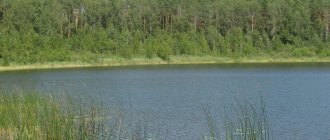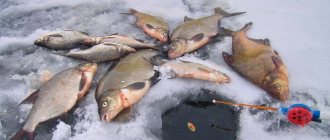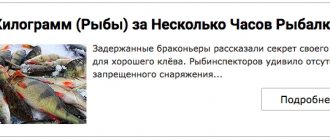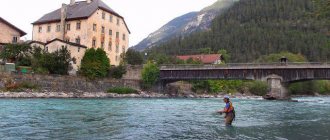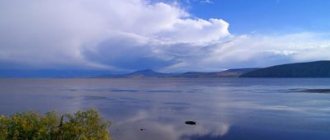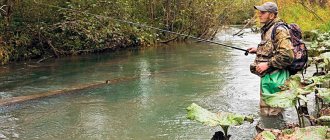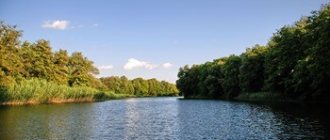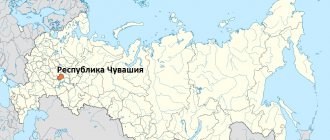Pskov region: history of the main river
Where does the Velikaya River begin in the Pskov region? It originates near Big Elm Lake. It is located on the Bezhanitskaya Upland. There is the source of the Velikaya River in the Pskov region. For more than 400 km, the river, fed by the waters of 47 tributaries, flows into a large lake complex located on the borders between the Pskov and Leningrad regions (Pskov-Peipsi Lake). On its winding path, the natural water flow passes through several small lakes, which freeze in winter and overflow their banks in floods in spring.
Coastal forests rich in a variety of game, a large number of fish in reservoirs and a mild climate have attracted people since ancient times. Archaeological excavations indicate that the first settlers on the banks of the river in the 5th century were representatives of the Baltic tribes (Krivichi), who over the course of several centuries mixed with Slavic culture. The surviving several earthen burial mounds confirm this version.
Around the 11th-12th centuries, the Latgalians (Eastern Baltic tribe) began to populate the banks of the river. They created their own settlements next to the Krivichi. After some time, the Velikaya River and its entire coastal zone became part of the Pskov Principality. And its settlers were forced to pay tribute to Pskov, like conquered tribes.
Over the centuries, cities and settlements were built on the Velikaya River in the Pskov region (its photo is presented in the article), the chronicle of which is inextricably linked with the historical events of Russia.

Lake Ezerische
Just like Yasskoye, it is very elongated in length. The area of the lake is 330 hectares, the average depth is 3 m, the maximum is 8 m. The coastal shallow water sometimes extends to 100 m, after which there is a rather sharp (about 20 m) drop into depth.
In the coastal zone of Ezerishche, rich aquatic vegetation (reeds and reeds) is developed; pondweeds, hornworts, telores, water lilies and egg capsules grow in silted reaches and bays. There is a strip of clear water in the middle of the lake. A real pike kingdom. There are several villages on the coast, inhabited mainly by summer residents. In the southeastern part of the lake there is a channel through which you can get to Lake Skubets. The Great River flows out of the lake in the northeastern part.
Ezerische is considered the most overgrown and fishy among the above lakes, which, unfortunately, attracts nearby poachers. Promising places are at the confluence of the Velikaya, as well as where the river flows out of the lake. The principle of fishing is the same as on Zverino - fishing for windows in aquatic vegetation. Non-snagging baits are most in demand here. The Rapala Minnow spoon works well; the use of small oscillating spoons equipped with a twister in combination with an offset hook is promising.
Since the lake is shallow, the water here warms up faster in the spring than in other bodies of water, which means you can start fishing earlier. There are several good tourist sites along the banks.
About the river
Now the Velikaya River in the Pskov region, 430 kilometers long, has a drainage basin area of 25,200 km². On its banks are the main regional centers Opochka and Ostrov, as well as the regional center Pskov.
The average depth of the Velikaya River in the Pskov region is 12 meters, and in some places, thanks to bottom depressions, it reaches a depth of up to 24 meters.
Near the villages of Poddubye and Maktyutino there are dams, thanks to which hydroelectric power stations operate that use the energy of the water mass. The average width of the Velikaya River in the Pskov region is 60 meters, and in the city itself - 100 meters.
DAM
The length of the Velikaya River is 430 km, its drainage basin area is 25,200 km², the river belongs to the Baltic Sea basin. In its narrowest places, the width of the Velikaya is only 7-10 m. In the spring, there is high water on the Velikaya up to one and a half meters. Freeze-up - from November to April. The Great River is navigable in its lower reaches. The cities of Opochka, Ostrov, and Pskov are located on the river. The Velikaya River flows into Lake Pskov 15 kilometers below Pskov, forming a small delta. The main tributaries of the Velikaya are Iritsa, Sinaya, Utroya, Kukhva, Vyada, Kudeb, Issa (left); Alol, Kudka, Sorot, Cherekha, Pskova (right).
In the upper reaches of the river flows a chain of lakes - Bolshoy Vyaz, Khodsho, Bolshoye Ostryo, Khvoino, Chenoe. Here we transfer to the kayak and begin the rafting. After the lakes, for 15 kilometers, the river, 7-10 meters wide, flows quickly through wooded banks, winding strongly. There are two dams on the river in this section. Downstream the river flows the large lake Veryato (Kopylkovskoye Reservoir) . At the exit from the lake, the width of the river is 15-20 meters, and here, near the village of Kopylok, there is the partially dismantled and now inactive Kopylkovskaya hydroelectric power station. Further, the river flows to the west, alternating stretches with small rocky rifts. The banks are very picturesque, covered with pine forest. In the area up to the mouth of the right tributary of the Aloli, the Velikaya River passes several more lakes - Bystroe, Yasskoe, Zverino and Ezerishche . Between Bystry and Yassky, near the village of Poddubye, there is the destroyed dam of the Poddubskaya hydroelectric power station.
To overcome some rapids we will need specialists in mountain rafting
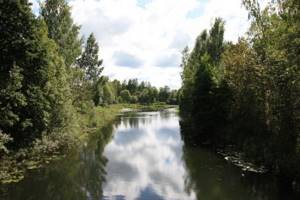
Velikaya River // Author: Pyotr Shitov
Interesting fact
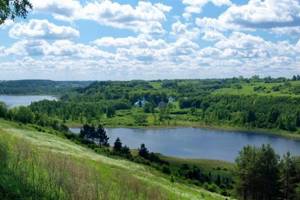
There is an interesting fact related to the river. In 1582, the Pskov chronicler recorded that crocodiles appeared in the Velikaya River in the Pskov region. They went ashore and caused great fear among the Pskovites.
Modern historians, having studied this record, came to the conclusion: this species of animal could not live here. Since their existence in the Velikaya River in the Pskov region requires year-round water with a positive temperature of at least 11 ° C, which does not correspond to the environment.
There is an assumption that in those days caravans from African lands passed through Pskov, where reptiles were often found to display animals at fairs and private menageries in Europe. And due to an oversight of the merchants, crocodiles ended up in the river, which later became extinct.
Fishing on the Velikaya River in the Pskov region

For fishing enthusiasts, the Velikaya River is the most popular body of water in the Pskov region. Large concentrations of fish are observed in the Yasskoye, Ezerishche, and Zverino reservoirs, which are located in the lower reaches of the river.
Lake Ezerishche is located on the territory of the Pustoshkinsky district (17 km from the regional center of Pustoshka, 175 km from Pskov). The area of the lake is 1.5 km². The average depth is approximately 3 meters, but in some places it reaches 8 meters.
Coastal aquatic vegetation (mainly reeds and reeds) near the Velikaya River in the Pskov region creates conditions for pike and its reproduction. If you sail to the middle of the lake, there is a strip of clean water where you can fish for crucian carp, roach, perch and other fish. Ezerische is shallow, and therefore the water warms up much faster in spring than in other bodies of water, which makes it possible to start fishing earlier.
Lake Zverino, 2 km long, is considered a natural landmark of the Pustoshkinsky district. The reservoir, with an area of 1.2 km², is considered flowing, since the Velikaya River passes through it.
The shoreline of the lake is indented. Thanks to this natural feature, Zverino has naturally beautiful bays. The largest estuary is considered to be the Kholyunovsky estuary, the shore of which is covered with various vegetation. In the middle of the lake there is an area of shallow depth (up to 3 meters), in demand by fishing enthusiasts. This bay hosts fishing competitions for pike, rudd, bream and other underwater creatures.
The popularity of this bay among fishermen lies in the fact that the burbot fish breeds and lives in its waters (the only representative of the cod family that lives in the fresh waters of lakes with a muddy bottom).
Lake Yasskoe (5.5 km²) is located 15 km from the regional center of the city of Pustoshka, it is considered a deep-sea reservoir. The lake is home to pike, perch, ide, tench, as well as large numbers of rudd and vendace.

Lake Iasi
The second largest reservoir in the Pustoshkinsky district.
Its area is about 550 hectares. The northwestern part of the lake is characterized by highly rugged shores: there are deep bays, peninsulas and islands. The banks are high and relatively flat. The average depth is 12 m, the maximum is 24 m, and sometimes there are areas with a depth of over 30 m. The length of the coastal shallow water zone ranges from 10 to 50 m, then there is a steep drop towards the lake bed. At the bottom there are deep-sea hollows with individual depressions up to 24 m, rocky and sandy shallows, or, as the locals call them, naliya. Along the shores there are 4 small villages (Simonovo, Yassy, Ustye and Drakunovo), which are not striking against the backdrop of the huge lake. The Velikaya River flows into the lake near the village of Ustye. The lake is home to pike, perch, ide, bream, tench, rudd, burbot, roach and vendace. Since the reservoir is deep-sea and has poorly developed bottom vegetation, it is logical to assume that in summer and at the end of winter the bottom layers of water are quite poor in oxygen and there are few fish there, and the most promising places for fishing are lilies, where the predator comes out to feed. The same rule applies in winter. Lake Yasskoye holds the regional record for the lowest water temperature at the bottom, and I strongly doubt that the predator stays there in deep-water holes in winter.
The main nali are located in the northeastern part of the lake. Particularly interesting is the “triangle” formed by Dvoretsky Island, a churchyard on the shore of the lake and a peninsula (this is almost opposite the source of the Velikaya River). There are vast fields of pondweed, in which predatory fish love to ambush. Depths on the buoys range from 1 to 4 m. Turntables, wobblers and jigs work well here. Once, on a Mepps Aglia Long No. 3 of a matte silver color, my friend caught an ide weighing almost 2 kg in this place. In winter, pike are excellently caught on spinners and jigs, and large sizes are also caught.
An interesting observation: ide often takes on a spinner without a feathered hook. Sometimes I even deliberately removed the wool edge from the tee of the spinner and achieved good results. Unfortunately, effective fishing in pondweed thickets is only possible in calm weather, when it is possible to make targeted casts. If you're a little nervous, polarized sunglasses will help. Very promising places are in the northwestern part of the lake, at the source of Velikaya, a large island to the right of the channel and not far from the road to Drakunovo, where there are also extensive shallow waters overgrown with aquatic vegetation. There are frequent cases of catching large specimens of pike. Near the large island, you can catch bream and rudd well with a fishing rod with a sliding float. There are places for tourist parking on the island and on the northwestern coast of the lake.
Attention winter fishermen! In the southwestern part of the lake, opposite the village of Simonovo, there are many underwater springs, and even in severe winters there are dangerous gullies there.
Recreation center "Alol"
How to spend a holiday on the Velikaya River in the Pskov region? Where should you locate? Considering that the Velikaya River attracts a lot of attention from nature lovers, the leadership of the Pskov region built recreation centers and hotels on its banks. The most popular are “Alol”, “Island Park”, “Skobar” and “Chistye Prudy”.
In the village of Kholyuny (the shore of Lake Zverino) there is a recreation center “Alol”, where vacationers are provided with a winter building, summer houses and cottages. On the territory of the camp site there is a canteen with three full meals a day, which is included in the price of the tour. A children's menu is available for children. There is a point where you can rent a boat or catamaran. The management of the base organizes various excursions around the Pskov region for vacationers.
Fishing
Fishing on the Velikaya River in the Pskov region will leave few people indifferent. Spinning fishers, bottom fishers, and float fishing rod lovers come here. There is a place for everyone, since the reservoir is quite diverse, has a heterogeneous topography, and many promising zones where fish linger.
They fish with spinning rods both in the upper and lower reaches of the river. In the upper and middle reaches the channel is winding, deep sections alternate with rifts, there are many promising whirlpools, return streams, and calm reaches. Here you can expect to catch a good perch, ide or pike. The best time for fishing is summer and early autumn.
Advice! Autumn is the best time to go to Velikaya for a predator.
In the lower reaches of the Velikaya River, the flow slows down, deep channel holes give way to swampy areas with gentle banks, abundantly overgrown with reeds and cattails. Here you can always catch a hefty pike or marketable perch, less often ide and chub.
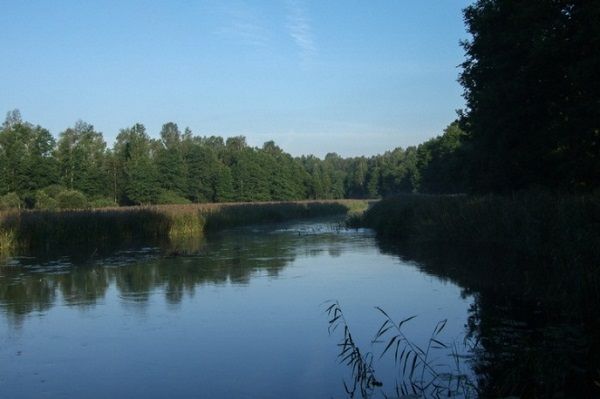
In some places it is impossible to fish from the shore; you will need an inflatable boat
Closer to the confluence with Lake Pskov, near the city of Pskov, pike perch are caught on a spinning rod. Moreover, it is not uncommon to catch truly trophy specimens reaching a weight of 7–8 kg. The deep areas are inhabited by catfish that grow up to 20 kg.
The mustachioed giant is caught using artificial bait, but it is much safer to use natural bait. The main ones are:
- live bait;
- leech;
- crawl out;
- frog;
- crayfish meat.
You can fish with a tackle with a dead fish or a donka loaded with a piece of rotten meat.
Fishing with bottom gear is most popular and widespread in the middle and lower reaches. There are many promising places where you can successfully hunt bream, silver bream, roach and other peaceful representatives of the ichthyofauna inhabiting the Velikaya River.
The most successful fishing is on the feeder. In small places or when fishing short, it is advisable to use a picker. At other points, at medium and great depths, equipment weighing from 70 to 100 grams is sufficient. Heavy feeders are not needed.
Both plant and animal baits work as baits. The first ones are relevant in the warm season. Among them we can recommend:
- canned corn;
- mastyrka;
- dough;
- boiled potatoes.
Lures of animal origin are more universal, but show better results in spring, late summer, autumn and, naturally, in winter when hunting from ice. Among them, we should note dung or earthworms, maggots, and bloodworms. Also, we must not forget about various insect larvae, especially caddis flies, dragonflies and others.
Fishing with a float rod is possible everywhere, from the upper reaches to the very confluence of Lake Pskov. They are caught with a classic swing on a blind and sliding rig; you can use a match and a lapdog, adapting to the fishing conditions. Baits and baits for the float are similar to the feeder.
"Island Park"
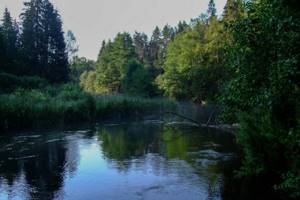
Several years ago, in the vicinity of the city of Ostrov, the Ostrov-Park hotel was built for tourists. On the territory of the complex there is a national Russian bathhouse, a boat pier, a children's playground with attractions for children of all ages, and two areas equipped for a picnic.
The menu of the hotel restaurant includes dishes of European and national cuisine. The hotel is located 1.5 km from the city center on 25 October Street.
In the village of Zagoritsy (12 km from Pskov), the guest yard “Skobar” operates all year round, where all conditions are created for those who want to spend their vacation time away from the bustle of the city.
The hotel has a café where breakfast is included in the price. One of the halls is designed for banquet events. The hotel is located 250 meters from the bank of the Velikaya River.
"Chistye Prudy"
In the village of Verkhovyane (Gdovsky district) on the shores of Lake Peipsi, which is located ten km from the Velikaya River, the guest complex “Chistye Prudy” was built, designed mainly for fishing lovers, where there is an opportunity to go fishing in any season of the year. Fishing from the shore and from a boat is allowed, using any fishing gear (float and spinning).
The base offers rental conditions for fishing equipment and boats of any displacement. On the territory of the base there is an area where you can cook your catch over a fire or on a grill. The hotel has wooden cottages and a cafe where breakfast is served, the cost of which is included in the price of your stay.
News
There are about 4,000 large and small rivers and lakes in the Pskov region - a real paradise for amateur fishermen, but, of course, you don’t want to go at random. So where can you go in July - August to relax and fish? For Fisherman's Day (July 14), PAI compiled the top 5 best, in the opinion of experienced fisherman and traveler Nikolai Besklyovny, places for fishing.
On June 15, the long-awaited motorboat season opened, and from July 1, motorized sailing on Tyoploe Lake (in water areas belonging to the Remdovsky reserve) is allowed. Choose options for fishing - I don’t want to. Now let's talk about everything in order.
The southern part of Lake Peipus is Storozhinets, Raskopel, Ostrovtsy, Podlipye, Podborovye. To get to these places from Pskov, you have to cover about 80-120 km, but it’s worth it. The best perch fishing begins here in July. This kind of fishing attracts both because of the beautiful open spaces and the size of the fish - specimens up to one kilogram can be found. Perch likes to stay on rocky places and “banks” (elevations of the bottom topography), of which there are many throughout the lake. They catch it by trolling with wobblers, casting with various baits, or using a jig. There is a high probability of taking away trophies from these places in the form of large pike, bream or even pike perch (if you are very lucky). If you have a boat with a motor, you definitely won’t be left without fish.
Forest lakes of the Pskov region. For example, Lake Velino in the Gdov region and lakes around the village of Yamm. There is a huge amount of bream here. It is better to ride it with feeder gear. You can fish both from the shore and from a boat. In such places both pike and perch are caught, although its size cannot be compared with its Chud counterpart. The float rod catches white (non-predatory) fish - roach, sagefish. In addition to fishing, you can relax by the fire, enjoy the surrounding forest, birdsong, pick berries, or even try your hand at picking fireweed.
River fishing is good at the mouth of the Velikaya River from the village of Khotitsy downstream to Lake Pskov. But lately fishermen who love quiet places have not come here. The mouth became too noisy due to the large number of fishermen on motor boats. If you are a fan of privacy, this is not your option. But the temptation is great, because here you can catch catfish, pike perch, pike, perch, and roach. There are a lot of fish, but also fishermen. The choice is yours. You can only get to the schools of fish by boat, because the mouth of the Velikaya River is very swampy, and it is not possible to fish from the shore. But if you take a boat to one of the many islands, you can try your luck from the shore with bottom and float fishing rods.
Sebezh lakes . The Sebezh region is a real lake region: there are about 75 large reservoirs alone, and countless small ones. The nature here is incredibly beautiful, and if you suddenly have no luck fishing, you definitely won’t leave here disappointed. This is definitely where eel fishing lovers should go. There is more of it in Sebezh lakes than anywhere else. An eel, as a rule, covets an ordinary worm from a bottom fishing rod or a “sliced” white fish; no special exotics are required.
Pskov Lake in the Talab Islands area . This place is also worth visiting not only for fishing, but also for the local beauty. If you can come to an agreement, you will be shown fishing spots known only to local residents. And they will not only show you, but also take you and give you the equipment. The Talab Islands have an abundance of perch, but the main attraction here is the zander fishing. There are holes between the islands that sometimes you can’t get a boat over, there are so many fishermen here. The pike perch crowd into the holes and are practically waiting to be caught. It is best to do this with a spinning jig. The hook may have a small silicone fish (twister) or a “cut” of roach fillet.
Bonus . From July 1, it is also allowed to fish on the rivers Zhelcha in the Gdovsky district and Chernaya in the Pskov region. The rivers are very fishy and picturesque. You should definitely go there. It’s better to go to the Black River with a boat; on Zhelche you can also fish from the shore - there are enough approaches to the water. You can fish with both bottom and float rods. On the Black River there is productive ide fishing. For a simple worm, specimens up to one kilogram can be found.
Rafting on the Velikaya River in the Pskov region
Many tourist organizations in the Pskov region, taking into account that the entire length of the Velikaya River (250 km) is suitable for rafting, organize this type of entertainment for thrill-seekers under the guidance of experienced instructors. Since the waters of some sections of the river have rapids, which alternate with a large number of lakes, rafting should be done on frame floating craft.
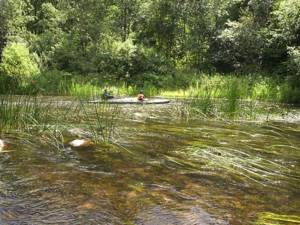
For tourists with children (over 7 years old) and those starting to learn the basics of this type of sports recreation, rafting organizers recommend an easy route that starts from the ancient city of Ostrov, founded in the 13th century. This route passes under the chain bridges - the main attraction of the city, built in the 19th century.
For fans of multi-day rafting, a rather difficult route has been developed, which starts from the bridge between the villages of Yushkovo and Torkhi. After ten kilometers, the river flows into Lake Khvoino, with an area of 2 km². Care should be taken when passing through this body of water. Since in some places its depth reaches 18 meters. Behind the reservoir begins a series of small lakes, the beauty of which fascinates nature lovers in the northwestern part of Russia.

